Feb 24, 2011
The Recent Drop In The Sea Surface Temperatures Of U.S. Coastal Waters
By Bob Tisdale
Bob does an excellent job tracking climate factors on his site. Here is an example with excerpts of a post on cooling of US ‘coastal waters’.
This post illustrates the recent drop in the SST anomalies of the U.S. coastal waters. We’ll represent this subset with the coordinates of 20N-50N, 130W-65W. I’ve used those coordinates in at least one earlier post about the SST Anomalies of U.S. “Coastal” Waters. Figure 1 is the December 2010 Reynolds OI.v2 SST anomaly map with those coordinates highlighted. The cooling appears to be an exaggerated response to the 2010/11 La Nina.

Figure 1
Figure 2 is the Reynolds OI.v2-based time-series graph for this subset. After the two-month flattening in September and October 2010, at approximately -0.24 deg C, the SST anomalies dropped more than 0.65 deg C by January 2011. The January 2011 reading for the U.S. Coast Waters is the lowest on record for the satellite-based Reynolds Oi.v2 SST dataset.
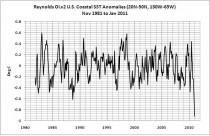
Figure 2
Note: This is not a post about global sea surface temperature (SST) anomalies, nor is it a post about the SST anomalies of the individual ocean basins. For those refer to the January 2011 SST Anomaly Update.
Figures 3, 4, and 5 show the long-term SST anomalies for the U.S. Coastal Waters using the HADISST, ERSST.v3b, and HADSST2 datasets. They provide a different perspective on the magnitude of the recent drop. For the HADISST and ERSST.v3b datasets, one has to go back to the April 1971 to find similar SST anomalies, and back to July 1933 with HADSST2 data.
The weekly data for this subset, Figure 6, show that the SST anomalies are rebounding. I’ll add this dataset to the monthly update for a few months to assure it rebounds fully.
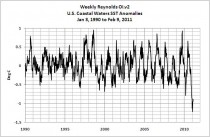
Figure 6
SOURCE
The map and all data presented in this post are available through the KNMI Climate Explorer.
Feb 23, 2011
New Light on “Delete Any Emails”
Steve McIntyre
New light today on Phil Jones’ notorious request that Mann, Briffa, Wahl and Ammann “delete any emails”.
The original email here is one of the most notorious Climategate emails. The UK Information Commissioner said that “more cogent” prima facie evidence of an offence under the FOI Act was impossible to contemplate, but noted a statute of limitations limited their jurisdiction. The UK Parliamentary Committee asked Muir Russell to investigate. Muir Russell refused. Muir Russell pointed out to the Committee in his evidence last fall that asking Jones about delete emails might result in the identification of an offence.
It was the second question considered by the inquiry stage of the two-stage Penn State process, articulated as follows:
2. Did you engage in, or participate in, directly or indirectly, any actions with the intent to delete, conceal or otherwise destroy emails, information and/or data, related to AR4, as suggested by Phil Jones?
The “inquiry” reported as follows:
He [Mann] explained that he never deleted emails at the behest of any other scientist, specifically including Dr. Phil Jones, and that he never withheld data with the intention of obstructing science; On January 15, 2010, and on behalf of the inquiry committee, Dr. Foley conveyed via email an additional request of Dr. Mann, who was asked to produce all emails related to the fourth IPCC report ("AR4"), the same emails that Dr. Phil Jones had suggested that he delete.
On January 18, 2010, Dr. Mann provided a zip-archive of these emails and an explanation of their content. In addition, Dr. Mann provided a ten page supplemental written response to the matters discussed during his interview.
They summarized their results as follows:
Allegation 2: Did you engage in, or participate in, directly or indirectly, any actions with the intent to delete, conceal or otherwise destroy emails, information and/or data, related to AR4, as suggested by Phil Jones?
Finding 2. After careful consideration of all the evidence and relevant materials, the inquiry committee finding is that there exists no credible evidence that Dr. Mann had ever engaged in, or participated in, directly or indirectly, any actions with intent to delete, conceal or otherwise destroy emails, information and/or data related to AR4, as suggested by Dr. Phil Jones. Dr. Mann has stated that he did not delete emails in response to Dr. Jones’ request. Further, Dr. Mann produced upon request a full archive of his emails in and around the time of the preparation of AR4. The archive contained e-mails related to AR4.
New Information from Eugene Wahl
The Inspector General of the Department of Commerce (to which NOAA belongs) has recently reported on an investigation of issues arising out of the Climategate emails. (They did not interview me or, to my knowledge, any critics.)
However, in their investigation, they interviewed Eugene Wahl, now a NOAA scientist. Astonishingly, Wahl was not interviewed by either the Penn State or UK inquiries. (Wahl is not named as such in the report, but is readily identified from the context.)
The original email request from Jones to Mann had asked:
Mike,
Can you delete any emails you may have had with Keith re AR4? Keith will do likewise… Can you also email Gene [Wahl] and get him to do the same? I don’t have his new email address. We will be getting Caspar [Ammann] to do likewise.
Cheers, Phil
Mann replied the same day as follows:
Hi Phil,
I’ll contact Gene [Wahl] about this ASAP. His new email is: generwahl@xxx
talk to you later,
mike
Wahl told the Inspector General that “he believes that he deleted the referenced emails at the time”. The excerpt from the report is as follows:
The timing is interesting here. Mann’s deletion request to Wahl came on May 29, 2008, only a few months before Wahl became an employee of NOAA (Aug 2008.) Because Wahl’s deletion of the emails took place prior to him becoming an employee of NOAA, NOAA policies on record retention were not applicable.
The question asked by Penn State was:
Did you engage in, or participate in, directly or indirectly, any actions with the intent to delete, conceal or otherwise destroy emails, information and/or data, related to AR4, as suggested by Phil Jones?
Previously we knew (from the Climategate emails) that Mann had told Phil Jones that he would ask Wahl to delete any emails on AR4. Now we know that Wahl “believes that he deleted the referenced emails at the time”.
Now this does not prove that Wahl deleted his emails on or about May 29, 2008 as a result of receiving an email from Mann asking him to do so - it might have been a coincidence. But - contrary to Penn State findings - it is certainly prima facie evidence warranting an investigation.
In earlier CA posts on the Penn State inquiry, I observed that Penn State thumbed their noses at Office of Research Integrity procedures for academic misconduct. These procedures state that first stage inquiries are only charged with determining prima facie evidence and should not attempt to make the findings that are the province of an investigation. Instead of adhering to ORI procedures, Penn State purported to make final findings on key issues (including deletion of emails) without a full investigation. The issue of email deletion should have been passed from the inquiry to an investigation and the investigation committee should have interviewed Wahl, before purporting to dispose of the matter. Post.
Feb 21, 2011
New York City Seasonal Snowfall Now 3rd Greatest in the Record (since 1868); Frigid Moscow
Joseph D’Aleo, CCM
New York City metro area after a welcome thaw late last week, saw cold return this weekend and then a light snow this morning. A snowblitz in January delivered 36 inches of snow, the second snowiest month, behind only the 36.9 inches set last February.
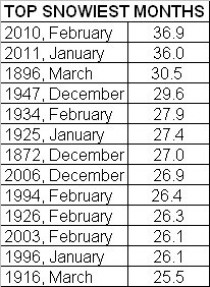
This moves the city into third place behind just 1947/48 and 1995/96.
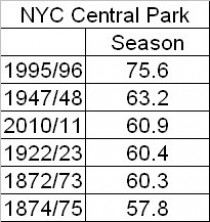
---------------------
Minneapolis received another foot of snow and now. Snowplows had trouble keeping up.

As of 6:00am on February 21st, this winter season is guaranteed to be at least the 11th snowiest on record in the Twin Cities. The current seasonal snowfall total stands at an impressive 73.4 inches. The average seasonal snowfall in the Twin Cities is 55.9 inches. The following graphs were both updated shortly after midnight on February 21st.
Snow Season Amount (inches)
1983-84 98.6
1981-82 95.0
1950-51 88.9
1991-92 84.1
1961-62 81.3
...
2010-11 73.6 (11th snowiest so far)
With an active stormy pattern and another month to go, both cities and more in between have a chance to advance in the seasonal rankings. See how NOAA study shows snow records last winter in Mid-Atlantic had natural causes.
Also see how Moscow Shivering In “Coldest Winter In 100 Years” Minus 30C for days...13C below normal...homeless people dying...hands and feet are freezing…
That’s what we are hearing from a few media outlets in Europe, those who have dared to mention the “cold-snap” word and to write about reality. It’s been cold in Scandinavia, much of Europe, North America and Russia too. Where’s all the warming? Heck, even the oceans are below normal.
Feb 21, 2011
Environmentalist fraud and manslaughter
By Paul Driessen
In the name of banning DDT, GEF bureaucrats are consigning millions to death from malaria
Many chemotherapy drugs for treating cancer have highly unpleasant side effects - hair loss, vomiting, intense joint pain, liver damage and fetal defects, to name just a few. But anyone trying to ban the drugs would be tarred, feathered and run out of town. And rightly so.
The drugs’ benefits vastly outweigh their risks. They save lives. We need to use chemo drugs carefully, but we need to use them. The same commonsense reasoning should apply to the Third World equivalent of chemotherapy drugs: DDT and other insecticides to combat malaria. Up to half a billion people are infected annually by this vicious disease, nearly a million die, countless survivors are left with permanent brain damage, and 90% of this carnage is in sub-Saharan Africa, the most impoverished region on Earth.
These chemicals don’t cure malaria - they prevent it. Used properly, they are effective, and safe. DDT is particularly important. Sprayed once or twice a year on the inside walls of homes, DDT keeps 80% of mosquitoes from entering, irritates those that do enter, so they leave without biting, and kills any that land. No other chemical, at any price, can do this.
Even better, DDT has few adverse side effects except minor, speculative and imaginary “risks” that are trumpeted on anti-pesticide websites. In the interest of saving lives, one would think eco activists would tone down their “ban DDT” disinformation. However, that is unlikely.
Anti-DDT fanaticism built the environmental movement, and gave it funding, power and stature it never had before. No matter how many people get sick and die because health agencies are pressured not to use DDT, or it is totally banned, Environmental Defense, Sierra Club, Greenpeace, Pesticide Action Network, and allied activist groups will never reform or recant.
Government agencies - including the US Environmental Protection Agency, National Institutes of Environmental Health Sciences, and Agency for Toxic Substances and Diseases Registry - will likewise continue pouring hundreds of millions of taxpayer dollars into anti-DDT research, in futile attempts to prove DDT causes some sort of meaningful harm. And the malaria death toll will continue to mount.
Worse, they have now been joined by the United Nations Environment Program, Global Environment Facility and even World Health Organization Environmental Division [ all of whom share the avowed goal of ending all DDT production by 2017, and banning all use of DDT in disease control by 2020.
A recent GEF “study” demonstrates how far they are willing to go, to achieve this goal, no matter how deadly it might be. The study purported to prove DDT is no longer needed and can be replaced by “integrated and environment-friendly” alternatives: for example, mosquito-repelling trees, and non-chemical control of breeding sites and areas around homes that shelter insects.
The $14-million study claimed that these interventions resulted in an unprecedented “63% reduction in the number of people with [malaria], without using DDT or any other type of pesticide.” However, as analyses by malaria and insecticide experts Richard Tren and Dr. Donald Roberts clearly demonstrate (see Research and Reports in Tropical Medicine and AEI Outlooks), the study, conclusions and policy recommendations are not merely wrong. They are deliberately misleading and fraudulent.
GEF did its 2003-2008 study in Mexico and seven Central American countries - all of which had largely ceased using DDT and other pesticides years before the GEF project. Instead of chemical sprays, these countries now employ huge numbers of chloroquine and primaquine (CQ and PQ) pills to prevent and treat malaria: 2,566 pills per diagnosed case in Mexico; 22,802 pills (!) in El Salvador; 50 to 1,319 pills per case in the other countries, according to 2004 health records.
It was these powerful drugs, not the “environment-friendly” GEF interventions, that slashed malaria rates. Indeed, they had begun to do so before GEF even arrived. This terribly inconvenient reality was further underscored by the fact that malaria rates were the same in “study” areas and “control” areas, where GEF did nothing - and that the number of malaria cases increased when the number of pills per case decreased. In other words, GEF could have gotten its same results using one bed net or one larvae-eating fish.
GEF’s fraudulent claims were then compounded by its insistence that the results and conclusions are relevant to other malaria-endemic regions. They are not. Malaria parasites in Latin American countries are Plasmodium vivax; in Africa and Southeast Asia, they are the far more virulent P. falciparum.
CQ and PQ are effective in preventing and treating vivax; they rarely prevent or cure falciparum malaria. Moreover, the eight Latin American countries have 140 million people. Sub-Saharan Africa has 800 million and a woeful medical and transportation infrastructure; Southeast Asia has 600 million people. Both have infinitely more malaria. Getting adequate medicines that work (far more expensive Artemisia-based ACT drugs) to 1.4 billion people would be a budgetary, logistical and medical impossibility.
But apparently none of these facts occurred to the bureaucrats who did this study. Thatís hardly surprising, since the project was designed and directed, not by disease control experts, but by the UNEP and radical environmental groups - which also spent millions distributing and promoting the study and other anti-DDT propaganda all over the world, ensuring that they received substantial media attention.
Anti-pesticide fanatics know this “study” is fraudulent. They just have a very high tolerance for how many malaria cases, brain-damaged people and dead babies are “acceptable” or “sustainable.” They just don’t care enough to bother learning basic facts about malaria, CQ versus ACT, vivax versus falciparum. They need to get out of the malaria control policy business and let medical professionals do their jobs.
(To learn more about stopping malaria, see Tren and Roberts’ book The Excellent Powder, Dr. Rutledge Taylor’s documentary film “3 Billion and Counting,” and the website for Africa Fighting Malaria.)
The final report claims its authors submitted manuscripts to prominent peer-reviewed medical journals. However, nothing was ever published. That suggests that they lied, and never submitted any manuscripts; or they did submit papers, but the manuscripts were rejected as being shoddy, unprofessional, unscientific, or even on par with Andrew Wakefield’s fraudulent vaccine-and-autism work.
To cap it all off, the bogus GEF project appears to have been conducted using funds diverted from already insufficient malaria control budgets. The GEF, UNEP, Stockholm Convention Secretariat and radical environmental groups are using money intended for malaria control to launch anti-pesticide programs in countries plagued by malaria, and gain control over public health policies, insecticides and programs.
Overall, the GEF has spent over $800 million on efforts to eliminate DDT and other “persistent organic pollutants” (POPs). It budgeted nearly $150 million in 2007 alone on its campaign to ban DDT production and use - but spent a lousy $22 million researching alternatives to DDT for vector control.
Until an equally effective and long-lasting substitute for DDT is developed - one that repels, irritates and kills mosquitoes - this vital weapon needs to remain in the disease control arsenal.
The GEF, UNEP, POPs Secretariat and WHO need to withdraw the study; discipline the people who perpetrated this fraud; retract World Health Assembly Resolution 50.13, calling for malaria-infested countries to slash their use of public health insecticides; and issue a statement making it absolutely clear that this “study” was erroneous and deceptive, and should not be considered in setting malaria policies.
Donors to the GEF and radical groups must be exposed. For activists and agencies to continue promoting this study or demand that malaria-endemic countries stop using DDT and insecticides, and adopt bogus “eco-friendly” GEF “solutions,” is gross medical malpractice - and deliberate manslaughter.
Malaria can be controlled, and even eradicated in many areas. We simply need to use every available weapon - including DDT, pesticides, nets, window screens, drugs and other interventions - in an orderly, coordinated and systematic manner; and ensure that mosquito infestations, disease outbreaks, malaria control successes and problems are monitored and evaluated accurately and honestly.
If we do that - and end the anti-pesticide hysteria - we can get the job done.
Paul Driessen is senior policy advisor for the Committee For A Constructive Tomorrow and Congress of Racial Equality, and author of Eco-Imperialism: Green power - Black death.
Feb 20, 2011
The Uncertainties of Averages
By Dr. Vincent Gray, NZCLIMATE TRUTH NEWSLETTER NO 261
Those who provide us with the supposed Mean Annual Global Temperature Anomaly (attached) treat the annual points in their graph as if they were constants. The points on the graph do not represent actual observations. They are processed versions of actual observations and they are subject to statistical uncertainties.
The latest CRU paper to calculate these uncertainties is:
Brohan, P., J J Kennedy, I. Harris, S. F, B, Tett, and P. D. Jones. 2006, Uncertainty estimates in regional and global observed temperature changes: A new data set from 1850. J. Geophys. Res. 111, D12106.doi:1020/2005JD006546.
This paper combine many sources of uncertainties and the final figures very from year to year, but are typically about plus/minus 0.2C on a 95% confidence basis. Some versions of their graph include these figures as “error bars” attached to the data points.
Brohan et al even admit that they do not include “Unknown unknowns”, even referring to the internationally recognized expert on this subject, Donald Rumsfeld.

Enlarged. The monthly uncertainties by location in 1969 according the Brohan etal paper. Notice how the greatest uncertainty is in the regions, where the data centers find the greatest warming.
It is surpising that they have left out of their discussions the most important source of uncertainty in their figures, one which is “known” to every person who has studied stratistics. It is the uncertainty which arises every time you take an average.
The actual experimental observations upon which the final figures on the graph are based are the daily measurements of the maximum and the minimum temperature at weather stations all over the world. In order to obtain the annual mean maximum or minimum it is necessary to average 365 daily measurements (366 in a leap year).
According to every one of the several textbooks on statistics that I possess. the equation for obtaining the uncertainty of a single mean is as follows uncertainty is plus/minus txSD/Sqrt of number of observations.
The value for t is obtained form the tables of the t distribution given in the textbooks. For 95% confidence limits and numbers of observations above 50 it is close to 2. The square root of 365 is 19.1.
Kerkin (personal communication) recently downloaded a large number of daily maximum and minimum measurements from the NIWA database and calculated the standard deviation, for two weather stations, Albert Park, Auckland and Te Aroha in the North Island of New Zealand. For Albert Park the SD for the maximum was 3.8C and for the mimimum 3.7C. For Te Aroha the SD for the maximum was 4.8C and for the minimum 5.1C.
I do not know how typical of the whole world these might be, but I expect that for countries with a continental climate the SD figures would be much higher. But, anyway, let us take an SD of 4.3C for he maximum and 4.4C for the minimum and try it in the formula.
The 95% confidence limits for the average are therefore plus/minus 2x 4.3/19.1 = 0.45C for the maximum and 2x 4.4/19.1 = 0.46C.
These figures are about double the uncertainties calculated by Brohan et al from all the other possible sources of error.
It is assumed that the average temperature is the mean of the maximum and the minimum. So you have to add up the individual uncertainties to give those for the mean as plus/minus 0.91C.
But that isn’t all. There is an addtional uncertainty from choosing such a bad method for calculation the average. There are no published figures as far as I am aware of attempts to calculate the error of doing this, or its uncertainty. However, NIWA have published a set of hourly temperature figures from 24 New Zealand weather stations for a typical summer’s day and a typical winter’s day at NIWA 2010 ”Meteorologist for a Day”.
I have calculated, from the 48 figures supplied, the averege difference between the Maximum/Minimum mean and the 24 Hour Mean as 0.2C with a standard deviation of 0.8C.
The 95% incertainty can again be calculated as plus/minus 2 x 0.8/sqrt of 48 which gives plus/minus 0.23C. This is an amount about the same as all the uncertainties calculated by Brohan et all.
If the 95% confidence limits are all added together you get 0.2+0.45+0.46+0.23 They come to a total of plus/minus 1.34C on each data point. This is well above the 0.9C claimed to be the global, or the New Zealand temperature rise over the last 100 years, which means that this figure has a very low probability of being correct.
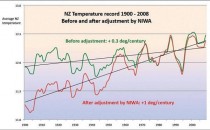
Enlarged. This has the NIWA NZ Seven Sisters Stations raw and NIWA adjusted.
Cheers
Vincent Gray
“To kill an error is as good a service as, and sometimes better than, the establishing of a new truth or fact” Charles Darwin as, and sometimes better than, the establishing of a new truth or fact” Charles Darwin”
|










